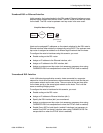
3. Configuring the DSL Router
6300-A2-GB20-10 November 2003
3-7
Network Address Translation (NAT)
The DSL router provides NAT, as described in RFC 1631, IP Network Address
Translator (NAT). NAT allows hosts in a private (local) network to transparently
access the external (public or global) network using either a block of public IP
addresses (Basic NAT) or a single IP address (NAPT). Static mapping enables
access to selected local hosts from outside using these external IP addresses.
NAT is used when a private network’s internal IP addresses cannot be used
outside the private network. IP addresses may be restricted for privacy reasons, or
they may not be valid public IP addresses.
Simultaneous Basic NAT and Network Address Port Translation (NAPT) is
supported. Refer to Simultaneous Basic NAT and NAPT on page 3-8 for additional
information.
Basic NAT
Basic NAT allows hosts in a private network to transparently access the external
network by using a block of public addresses. Static mapping enables access to
selected local hosts from the outside. Basic NAT is often used in a large
organization with a large network that is set up for internal use, with the need for
occasional external access.
Basic NAT provides a one-to-one mapping by translating a range of assigned
public IP addresses to a similar-sized pool of private addresses (typically from the
10.x.x.x address space). Each local host currently communicating with a external
host appears to have an unique IP address.
IP addresses
A total of 256 IP addresses can be allocated for use with Basic NAT. Two IP
addresses are reserved, and 254 IP addresses are available for use. Up to
64 static mappings can be configured.
Network Address Port Translation (NAPT/PAT)
NAPT allows multiple clients in a local network to simultaneously access remote
networks using a single IP address. This benefits telecommuters and SOHO
(Small Office/Home Office) users that have multiple clients in an office running
TCP/UDP applications. NAPT is sometimes referred to as PAT (Port Address
Translation).
NAPT provides a many-to-one mapping and uses one public address to interface
numerous private users to an external network. All hosts on the global side view
all hosts on the local side as one Internet host. The local hosts continue to use
their corporate or private addresses. When the hosts are communicating with
each other, the translation is based on the IP address and the protocol port
numbers used by TCP/IP applications.


















